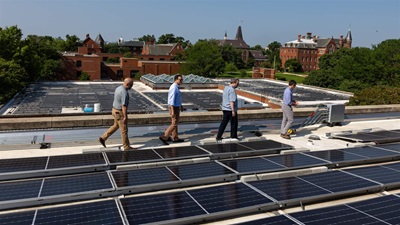A Historic University’s Microgrid Cuts Energy Costs and Benefits Local Community
Gallaudet’s solar and battery storage system shows reliability of distributed energy resources

More than 150 years after its founding, the world’s first university for the deaf and hard of hearing is making a different kind of history.
Gallaudet University in Washington, D.C., is reaping the benefits of one of the largest microgrids in the city, which school officials installed on the campus in 2023.
A microgrid is an energy system that can operate independently from the main grid. Gallaudet’s microgrid combines multiple forms of distributed energy resources, including hundreds of solar panels spread across seven rooftops; any energy the school doesn’t use immediately can be stored in a campus battery.
By producing most of its own energy on-site, Gallaudet is easing the burden on the local utility grid—and the university’s energy bill.
“The main reason for the microgrid is it’s going to save the university a lot of money,” said Dave Good, director of energy, utilities, and sustainability at Gallaudet University. “We anticipate it’s going to save about 40% on our energy bills every year, which is millions of dollars. It’s a very good investment. It’s going to have a relatively quick return.”
The microgrid has other benefits: It’s a resilient backup in the event of grid outages—no small matter in an era of increasingly frequent severe weather—and provides clean energy to D.C. neighborhoods through Washington’s community solar program, administered through local utility, Pepco.
Area residents who subscribe to the community solar program receive credits on their electricity bills, reducing their monthly electric bills by up to 10%. To date, more than 400 households have subscribed to Gallaudet’s community solar offering.
“We have all this space and we’re able to maximize the economic and environmental benefits, and the community benefits through the community solar program,” Good said.
Good and experts from the clean energy financing initiative Urban Ingenuity (an affiliate of Working Power, an organization that co-develops clean energy projects) and distributed energy company Scale Microgrids worked together to develop the microgrid. Officials from each entity led a tour for staff members from The Pew Charitable Trusts and university faculty to showcase the facility and explain distributed energy resources and the benefits they yield for the campus and community.
Good explained that the university uses a single “point of common coupling,” or one dedicated point, where Pepco delivers electricity to the university. That grid design allows Gallaudet to easily switch from the Pepco grid to the school microgrid when needed.
The formation and economics of the project are distinct. In 2015, Urban Ingenuity conducted a citywide microgrid study, with support from the D.C. Department of Energy and Environment. The study identified Gallaudet as a top contender for a microgrid system based on criteria and a scoring system that balanced economic, financial, and regulatory concerns.
As part of the project agreement, the university earns revenue from leasing rooftops for solar arrays to Scale Microgrids. The battery energy storage also helps the grid operator for the mid-Atlantic region, PJM, safely and reliably deliver electricity through its “frequency response program.” This allows the university to earn revenue from the energy it provides while assisting PJM in balancing energy supply and demand.
Dr. Christopher Hayes, an assistant professor of mathematics at Gallaudet who joined the tour, said energy costs are frequently a topic of conversation in his classroom.
“Students are, of course, naturally interested in green energy, but they rarely know what the costs of electricity are in daily life,” Hayes said. “The microgrid will help me give a concrete, real-world example that they can study, and help them appreciate that green energy can be the smart economic choice. I think it’s a great opportunity.”
Good is also excited about the energy reliability the microgrid provides, including during weather-related outages. “We’ll continue to be able to operate campus and really have almost no disruption at all,” he said. “When we’re disconnected from the grid, that’s called ‘islanded’ because we’re on an island of electricity generation on the campus. We’ve already tested this out a few times and were able to operate the entire campus using electricity from our microgrid. So, it’s proven, and it is an exciting benefit.”
Today, there are hundreds of microgrids around the United States, including at other universities and many facilities that depend on electricity to operate essential services—fire stations, hospitals, and wastewater treatment plants, among others.
Developing a microgrid project can be a complicated process that requires expertise to navigate regulatory, engineering, and financial complexities. However, Bracken Hendricks, co-founder and CEO of Urban Ingenuity, said microgrid technologies are advancing quickly and, with growing energy demand and rising utility bills, more microgrids may soon be operational in the U.S.
“It’s really a solid economic payback,” Good said. Further, he added, the microgrid “helps Gallaudet to achieve its mission to educate deaf and hard of hearing students.”
Maureen Quinlan is a senior officer and Brian Watts is an officer with The Pew Charitable Trusts’ energy modernization project.











